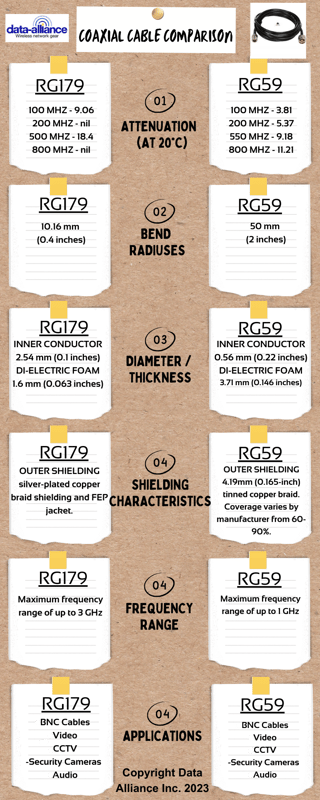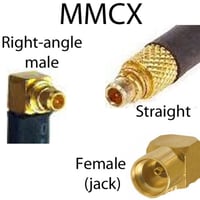BNC Cables for Audio Video
BNC Cables for Video CCTV and Audio
Very high quality cables for security cameras and audio applications.

BNC: A Quick-Connect / Quick-Release Connector
The BNC connector is a specialized connector used with co-axial cable and designed to work at multi-megahertz radio frequencies. This miniature connector maintains the co-axial cable shielding and provides a low impedance connection that can be rapidly assembled and dismantled.
- BNC is a locking, round connector with slotted mating collar.
- Quick-connect / quick release connector for coaxial cable: BNC connectors connect with a half-turn.
- These connectors twist and lock onto the jack, with a half-turn, unlike SMA, N, and RP-TNC, that have threaded connections.
- BNC is used in situations where quick disconnect capabilities are required or convenient.
- The ability to effortlessly disconnect and connect securely enables devices to have easily removable / retractable antennas or BNC extension cables for rapid swapping.
Gender is determined by the inside wire - not the outside connector.
BNC is not only used for antenna cables, but also for CCTV and other video applications, audio, TV receivers, and networking coax applications.
BNC RF connector is used for terminating a variety of miniature to standard RG coax cables. Terminating a coax cable to the connector can be done either by clamping or crimping.
BNC Connector Structure and Function
The BNC connector comprises:
- A male part which typically is attached to a coax cable.
- A female connector usually anchored to the relevant piece of equipment.
BNC connectors mate using a bayonet connection:
- Radial pins on the male interlock with
- L-shaped slots on the female connector with a quarter turn. This is a secure connection which is not easily dislodged or accidentally pulled out.
Within the connector there is:
- A center pin or contact
- An inner contact area
- An outer contact layer
- And a die-cast BNC connector body/housing
The terminus of the connector can be either crimped or soldered.
- Crimp type BNC connectors can be accurately matched and attached to a trimmed and stripped coax cable with an appropriate crimping tool. They comprise a crimp outer sleeve known as a ferrule as well as a center pin that can also be crimped.
- Solder type BNC connectors Are more difficult to install but are an alternative where the more common crimp type connectors are unavailable. These connectors are again attached to trimmed and stripped cable. They possess a solder center pin and connect the braid of the coax cable to an inner ferrule with a stuffing-nut attachment.
These connectors have been made to match the impedance of the BNC cable to which they are attached and are typically available with 50 ohm or 75 ohm impedance typically. BNC connectors usually work with frequencies of 4GHz or less with the 75 ohm connector specified for frequencies of around 2 GHz.
BNC cable and connector applications
Originally developed for military use, BNC cables and connectors were initially adapted for use in early computer networks particularly those using Ethernet. The uses of BNC cables have since expanded to include a wide variety of Radio Frequency (RF) applications including:
- Aerospace: BNC connectors create a stable and robust connection that can endure the environmental pressures, temperature and pressure changes and vibrations experienced in aviation.
- Test equipment: BNC cables and connectors offer ease of use and a secure connection in test equipment such as audio generators, power meters and oscilloscopes.
- Television: The 50 and 75 ohm impedances of BNC connectors enable them to efficiently carry signal rather than power over distances making them a favorable choice in the television industry. New ranges of custom and modified BNC HD connectors are now finding use for HDTV applications also.
- Video: BNC has an ideal impedance for video and the coax cable provides well shielded transmission.
- Radio: BNC Antennas with a BNC antenna extension have a wide variety of Radio Frequency applications making them useful in Ham radio connections. A BNC antenna can be connected to a BNC antenna extension cable for a variety of radio applications working across AM, FM, HF, UHF and VHF frequencies. A number of omni-directional antennas can be acquired that will work with the BNC connector.
- Audio The secure bayonet connection of BNC connections and cables work for digital audio input and output where they are thought to increase signal accuracy.
BNC Connector Combinations and Variants
Given the wide range of applications for the BNC connector it is no surprise that there are broad range of BNC connector and cable combinations, BNC connector adapter and BNC cable adapter products to provide exact solutions for the varied set-ups for which BNC connectors are required. BNC adapters are useful in most applications where they provide a greater range of mating combinations. Adapter types include:
- The "straight through adapter’ which permits a BNC male to BNC male cable connection
- Adapters which have two female connectors at either horizontal end and a male connector at the bottom which can facilitate multiple male to female BNC cables being connected at a single point.
- Inter-series adapters facilitate connections between different types of connector.
- BNC Mini or mini BNC connectors are around 40% smaller than the original BNC connector and offer the utility and security of a BNC where space is limited or much smaller diameter BNC extension cable is used. Mini BNC to BNC cable is used for frequencies up to 2GHz. Mini BNC to BNC adapter set-ups further extend the versatility of this established and reliable connector.
BNC cables for Video and Audio are 75 Ohm:
- BNC Male to Female Cables (75 Ohm): Video and Audio applications
- BNC Male to Male cables (75 Ohm): Video and Audio applications
History
BNC stands for Bayonet Neill-Concelman connector. Bayonet represents the physical connector kind and Neill and Concelman are the inventors of the BNC connector (invented in the late 1940s).
BNC cables for wireless applications are 50 Ohm:
- All of our 50 Ohm BNC cables for wireless applications have "50 Ohm" mentioned in the title of the product page.
Video and Audio in IoT: Applications of BNC Cables and Adapters in the Internet of Things
Introduction
The Internet of Things (IoT) has ushered in a new era of connectivity, where everyday objects are becoming smarter and more interconnected. IoT applications encompass a wide range of devices, and among the key aspects of many IoT deployments is the transmission of video and audio data. In this section of the article, we will explore how video and audio are integral to IoT solutions and how BNC (Bayonet Neill-Concelman) cables and adapters play a crucial role in facilitating high-quality audio and video communication.
The Significance of Video and Audio in IoT
Video and audio data are essential components of many IoT applications, adding a valuable layer of information and enhancing the overall user experience. Here are some key areas where video and audio are vital:
-
Surveillance and Security: IoT-based security systems rely heavily on video data to monitor premises and identify security threats. Audio data can also be used for two-way communication or detecting unusual sounds, enhancing the effectiveness of security solutions.
-
Industrial Monitoring: In industrial IoT deployments, video feeds provide real-time visibility into manufacturing processes and equipment. Audio feedback can be used for monitoring machine sounds, enabling predictive maintenance and early fault detection.
-
Smart Homes: In smart home IoT applications, video and audio data enable users to remotely monitor their homes, communicate with family members, and interact with smart home devices using voice commands.
-
Healthcare: Video and audio sensors are used in telemedicine and remote patient monitoring, allowing healthcare professionals to visually assess patients and communicate with them remotely.
-
Retail and Customer Engagement: IoT-enabled digital signage and interactive kiosks often include video displays and audio announcements to engage customers and provide information.
BNC Cables and Adapters: The Backbone of Video and Audio Connectivity
BNC cables and adapters have a long-standing reputation for their reliability and suitability for high-frequency signals. In IoT applications involving video and audio data, BNC connectors are preferred for several reasons:
-
High-Quality Signal Transmission: BNC connectors and cables are capable of transmitting high-quality video and audio signals over considerable distances without signal degradation. This is crucial for maintaining the integrity of video feeds and ensuring clear audio communication.
-
Ruggedness and Durability: IoT deployments can occur in diverse environments, including outdoor locations and industrial settings. BNC connectors are known for their robust construction, resistance to environmental factors, and ability to withstand physical stress, making them ideal for harsh conditions.
-
Easy Installation: BNC connectors feature a bayonet coupling mechanism, allowing for quick and secure connections without the need for specialized tools or expertise. This ease of installation is valuable in IoT deployments that require scalability and rapid setup.
-
Compatibility: BNC connectors and adapters are available in various configurations, making them compatible with a wide range of video and audio equipment. This versatility allows IoT developers to customize their connectivity solutions to meet specific requirements.
-
Adaptability: BNC adapters can convert BNC connections to other common connectors like RCA or F-type connectors, enabling seamless integration with existing audio and video equipment.
Conclusions
Video and audio data are integral components of many IoT applications, enhancing their functionality and user experience. BNC cables and adapters, known for their reliability, durability, and high-frequency capabilities, serve as the backbone of video and audio connectivity in the IoT ecosystem. As IoT continues to evolve and expand into various industries, the importance of BNC cables and adapters in facilitating seamless and high-quality video and audio communication remains unquestionable. Whether in security, healthcare, industrial automation, or smart homes, BNC connectors play a pivotal role in ensuring that IoT devices can effectively capture, transmit, and process video and audio data.







